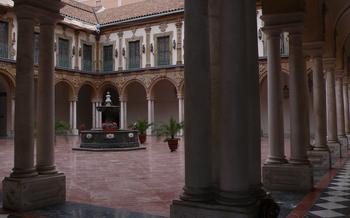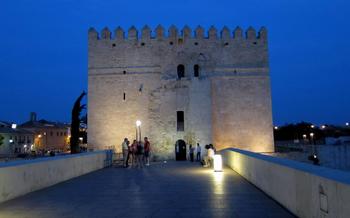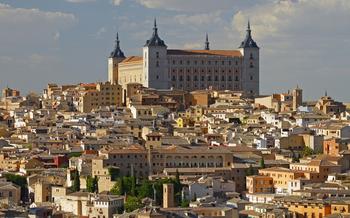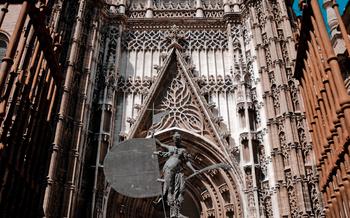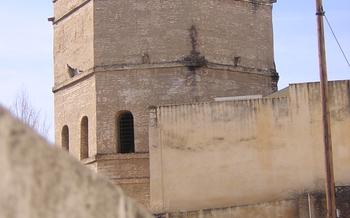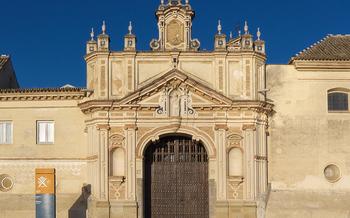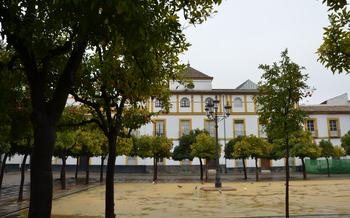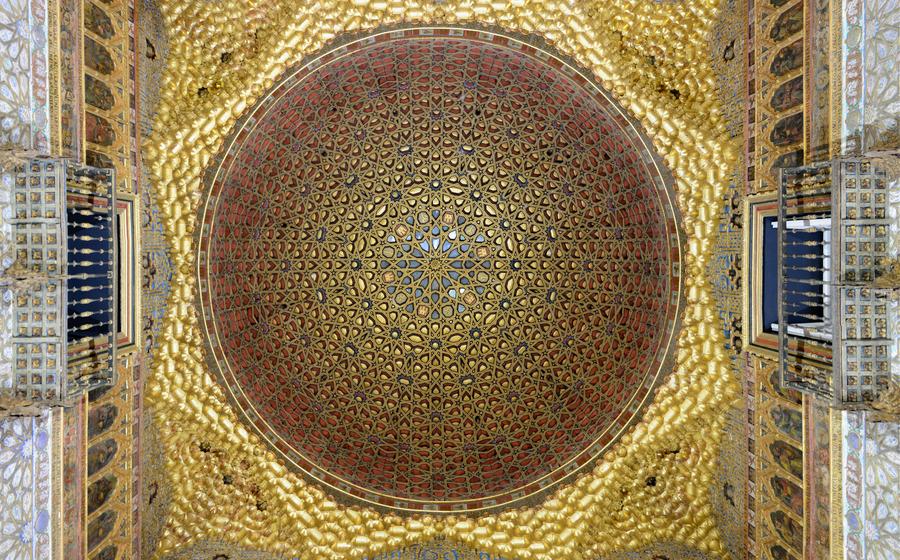
Alcázar of Seville
- The Alcázar of Seville: A Majestic Masterpiece
- A Walk Through History
- Exploring the Alcázar's Enchanting Gardens
- Marveling at the Mudéjar Architecture
- The Alcázar's Royal Apartments
- Discovering the Hall of the Ambassadors
- Exploring the Hall of the Admirals
- Strolling Through the Patio del Yeso
- Unearthing the Archaeological Museum
- Witnessing the Changing of the Guard Ceremony
- Tips for Visiting the Alcázar
- Getting to the Alcázar
- A Glimpse into the Future of the Alcázar
- Unforgettable Memories at the Alcázar of Seville
The Alcázar of Seville: A Majestic Masterpiece
The Alcázar of Seville is a magnificent architectural wonder that stands as a testament to Spain's rich history and diverse cultural influences. With its deep-rooted historical significance and stunning architectural styles, this UNESCO World Heritage Site has become a must-see attraction for travelers from around the globe.
The Alcázar's origins can be traced back to the 10th century when it served as a fortress for the Moorish rulers of Seville. Over the centuries, it underwent numerous transformations and expansions, reflecting the changing political and cultural landscape of the city. Under the patronage of Christian monarchs like Peter I and Alfonso X, the Alcázar was transformed into a royal palace, showcasing the opulence and grandeur of the Spanish monarchy. Today, it stands as a living testament to Spain's rich heritage, embodying the fusion of Islamic, Gothic, and Renaissance architectural styles.
A Walk Through History
The Alcázar of Seville has a rich history that spans over a thousand years. Its origins can be traced back to the 10th century when the Muslim rulers of Seville built a fortress on the site. Over the centuries, the fortress was expanded and transformed by successive rulers, including the Christian monarchs who conquered Seville in 124The Alcázar became the residence of the Spanish monarchs during their visits to Seville, and it served as the seat of government for the Kingdom of Seville. The Alcázar is a symbol of power and grandeur, and it has been witness to some of the most important events in Spanish history.
Exploring the Alcázar's Enchanting Gardens
Amidst the grandeur of the Alcázar's palaces and halls, visitors can find solace and tranquility in its enchanting gardens. These verdant havens, meticulously manicured and adorned with a symphony of colors and fragrances, offer a delightful respite from the bustling city streets.
Strolling along the garden paths, visitors are greeted by a kaleidoscope of vibrant blooms, from delicate roses to fragrant jasmine. Water features and fountains murmur gently, creating a soothing ambiance that invites relaxation. Orange tree groves, heavy with their golden fruit, perfume the air with their sweet citrus scent.
These gardens are a testament to the Moorish influence on the Alcázar. The intricate water management system, with its channels and pools, reflects the Islamic tradition of harnessing nature's resources for both beauty and practicality. The lush greenery and abundance of citrus trees evoke the fertile gardens of the Alhambra in Granada, another masterpiece of Islamic architecture.
For weary travelers and history buffs alike, the Alcázar's gardens offer a tranquil oasis amidst the city's vibrant energy. It's a place to wander aimlessly, soak in the beauty of nature, and let the stresses of everyday life melt away.
Marveling at the Mudéjar Architecture
A captivating blend of Islamic and Gothic elements characterizes the Alcázar's architectural style, known as Mudéjar. This unique fusion is evident throughout the palace, from its intricate tilework to its delicate carvings. The Alcázar stands as a testament to Spain's rich cultural heritage, embodying the harmonious coexistence of different civilizations.
The Alcázar's Mudéjar elements are particularly striking in the Hall of the Ambassadors, where the ceiling features intricate carvings and geometric patterns. The Hall of the Admirals, dedicated to Spanish explorers, also showcases stunning Mudéjar details, including colorful tiles and decorative plasterwork.
One of the most iconic examples of Mudéjar architecture in the Alcázar is the Patio de las Doncellas, the palace's central courtyard. Surrounded by elegant arches and adorned with intricate tilework, this courtyard is a masterpiece of Mudéjar design. Its serene beauty and harmonious proportions create a tranquil oasis amidst the bustling city.
The Alcázar's Mudéjar architecture is a testament to the skill and artistry of the craftsmen who worked on its construction. This unique style, blending Islamic and Gothic influences, is a defining characteristic of the Alcázar and a source of fascination for visitors from around the world.
The Alcázar's Royal Apartments
Adorned with opulent furnishings and intricate decorations, the royal apartments of the Alcázar offer a glimpse into the lavish lifestyle of the Spanish monarchs. These private chambers, once reserved for royalty, are a testament to the grandeur and opulence of the Alcázar. Visitors can marvel at the exquisite tapestries, elegant chandeliers, and ornate furniture that adorn these grand spaces. The throne room, with its majestic throne and elaborate ceiling frescoes, exudes an aura of power and authority. The reception halls, where royal guests were once entertained, are adorned with shimmering chandeliers, polished marble floors, and opulent tapestries depicting scenes from Spanish history. These royal apartments provide a fascinating glimpse into the lives of the Spanish monarchs who once resided within the Alcázar's walls.
Discovering the Hall of the Ambassadors
In the heart of the Alcázar of Seville, the Hall of the Ambassadors stands as a testament to the palace's grandeur and diplomatic significance. This magnificent hall, with its soaring Mudejar-style ceiling adorned with intricate carvings, served as a grand reception space for the Spanish monarchs to receive foreign dignitaries and conduct important ceremonies.
The ceiling of the Hall of the Ambassadors is a masterpiece of Mudéjar craftsmanship, showcasing the harmonious blend of Islamic and Gothic elements that define the Alcázar's architectural style. The intricate carvings depict scenes from history, mythology, and religion, creating a visually captivating spectacle that leaves visitors in awe.
Beyond its aesthetic beauty, the Hall of the Ambassadors holds historical significance as the venue for pivotal diplomatic meetings and ceremonies. Here, ambassadors from far-off lands presented their credentials to the Spanish monarchs, seeking alliances, negotiating treaties, and forging diplomatic bonds.
The walls of the hall are adorned with portraits of Spanish kings and queens, adding to the regal atmosphere of the space. These portraits serve as a reminder of the power and prestige that emanated from the Alcázar, which was not only a royal residence but also the seat of government for the Spanish monarchy.
Today, the Hall of the Ambassadors continues to be a popular attraction for visitors to the Alcázar of Seville. Its stunning architecture, rich history, and symbolic importance as a center of diplomacy make it a must-see destination for anyone seeking to delve into the cultural heritage of Spain.
Exploring the Hall of the Admirals
Deep within the Alcázar's walls lies the Hall of the Admirals, a testament to Spain's rich maritime history. Dedicated to the brave explorers who ventured across the vast oceans, this grand chamber is adorned with portraits of famous admirals, each with their own tale of courage and discovery. Maps and navigational instruments, once used to chart unknown waters, hang on the walls, creating an atmosphere of adventure and exploration.
In the center of the hall, a large globe stands as a symbol of the world that these intrepid sailors traversed. Its intricate details depict the continents, oceans, and sea routes that they followed, connecting Spain to distant lands and forging new empires. The Hall of the Admirals is not just a tribute to Spain's maritime prowess; it is a reminder of the human spirit's insatiable thirst for knowledge and the pursuit of new horizons.
Strolling Through the Patio del Yeso
Tucked away within the Alcázar's sprawling grounds lies the Patio del Yeso, an intimate and serene courtyard that invites visitors to pause and contemplate. The central fountain, surrounded by elegant arches and columns, creates a tranquil atmosphere that contrasts with the bustling activity of the surrounding palace.
Once used as a private garden for the royal family, the Patio del Yeso exudes a sense of seclusion and tranquility. Its symmetrical layout, with neatly trimmed hedges and colorful flower beds, adds to its charm. Visitors can wander along the covered walkways, admiring the intricate tilework and the delicate tracery of the arches, or simply relax on one of the benches and soak in the peaceful ambiance.
As the sun casts long shadows across the courtyard, the Patio del Yeso transforms into a magical setting, perfect for quiet contemplation or intimate conversations. It is a hidden gem within the Alcázar, a place where visitors can escape the crowds and experience the timeless beauty of this historic palace.
Unearthing the Archaeological Museum
Within the sprawling grounds of the Alcázar, a hidden gem awaits discovery: the Archaeological Museum. This treasure trove of artifacts offers a fascinating glimpse into the Alcázar's rich past and the diverse cultures that have shaped it.
The museum houses an impressive collection of archaeological finds excavated from the Alcázar's grounds and surrounding areas. Roman mosaics, intricately decorated Islamic pottery, and medieval weapons are just a few of the treasures that await visitors. These artifacts provide a tangible connection to the Alcázar's long and storied history, as well as the broader tapestry of Seville's past.
A visit to the Archaeological Museum is a must for anyone interested in delving deeper into the Alcázar's history and the cultures that have influenced its development. It offers a unique opportunity to explore the layers of history that lie beneath this magnificent palace and gain a deeper appreciation for its enduring significance.
Witnessing the Changing of the Guard Ceremony
Every Monday at 12 pm, the Alcázar comes alive with the spectacle of the Changing of the Guard ceremony. This traditional military ritual, performed by the Spanish Royal Guard, is a sight to behold. The soldiers, resplendent in their colorful uniforms and plumed helmets, march with precision to the rhythm of military drums. The ceremony takes place in the Alcázar's main courtyard, the Patio de Banderas, and is a popular attraction for visitors from around the world. It is a chance to witness a piece of Spanish history and pageantry, and a unique experience that should not be missed.
Tips for Visiting the Alcázar
To make the most of your visit to the Alcázar, consider booking your tickets in advance, especially during peak tourist season. Guided tours are also available, providing an in-depth exploration of the palace's history and architecture. Allow at least two hours for your visit to fully appreciate the Alcázar's many wonders. Remember to dress respectfully, as the Alcázar is a royal palace and a UNESCO World Heritage Site. By following these tips, you'll have a memorable and enriching experience at this iconic landmark.
Getting to the Alcázar
The Alcázar is conveniently located in the heart of Seville, within easy reach of major landmarks and public transportation. Visitors can take a leisurely stroll from the iconic Seville Cathedral, just a few minutes away, or hop on the city's efficient bus network, with several lines stopping nearby. For those arriving by car, there are multiple parking options in the vicinity, ensuring a hassle-free visit to this architectural gem.
A Glimpse into the Future of the Alcázar
The Alcázar of Seville, steeped in centuries of history, continues to evolve and captivate visitors with its timeless beauty. As we look to the future, several exciting projects are underway to enhance the experience for visitors. The ongoing restoration efforts aim to preserve the Alcázar's architectural integrity and uncover hidden treasures that have been concealed over time. Future plans include interactive exhibits, immersive experiences, and educational programs designed to engage visitors of all ages. With these initiatives, the Alcázar of Seville is poised to remain a vibrant cultural landmark that tells the story of Spain's rich history while embracing the possibilities of the future.
Unforgettable Memories at the Alcázar of Seville
The Alcázar of Seville is an awe-inspiring testament to the rich history and cultural heritage of Spain. With its majestic architecture, enchanting gardens, and fascinating interiors, it offers a journey through time that is both immersive and unforgettable. As you wander through its grand halls and admire the intricate details of its every corner, you'll be transported back to an era of kings, queens, and conquistadors. Whether you're a history buff, an architecture enthusiast, or simply someone who appreciates beauty, the Alcázar of Seville is an absolute must-see that will leave you with lasting memories and a renewed appreciation for the wonders of the world.
